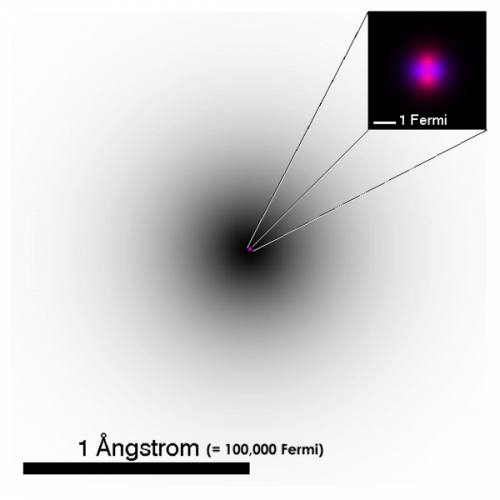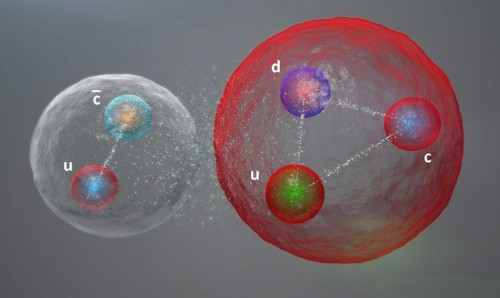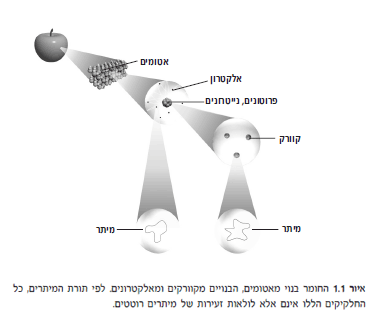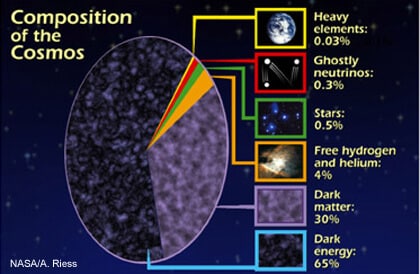A few days ago we were informed that the scientists of the CERN particle research center in Switzerland (the particle accelerator LHC) found evidence of the existence of a new subatomic particle called "Pentaquark". The new discovery is related to the question of what the material consists of and what is the smallest part of the material

A few days ago we were informed that the scientists of the CERN particle research center in Switzerland (the particle accelerator LHC) found evidence of the existence of a new subatomic particle called "Pentaquark". The new discovery is related to the question of what the material consists of and what is the smallest part of the material. This is an intriguing question that to this day has no solution, even though we have already made impressive progress on the way to answering it. The Greek philosophers, for example, were divided in their opinions. Some thought that logically it made sense that the material could be divided further and further without limit. In front of them were the philosophers who argued that this does not make sense because if we divide the matter further and further, in the end there will be nothing left and we will reach the void. Because it doesn't make sense that matter is made up of nothing, they argued that there must be the smallest part of matter that cannot be further divided - the atom.
After about two thousand years, the atomic idea received a serious boost. In the 19th and 20th century we did discover that all visible matter is composed of the same structure and therefore we called this structure atom as the ancient Greeks suspected. But it is not really a matter that does not consist of something smaller. The atom is made up of subatomic particles. At its center is the nucleus, which is composed of protons and neutrons and around them is a cloud of electrons. Subsequently, many more subatomic particles that do not make up the atom were discovered.

Now the question arises, what are these subatomic particles made of? Are they the smallest pieces of matter or are they also composed of even smaller particles? And will there be an end to these divisions?
Today we still do not have answers to all these questions, but we have come to many insights. Among the subatomic particles there are different families and not all the subatomic particles make up the material at all!
The boson family, for example, are particles that do not build matter but carry the various forces in nature (the electromagnetic force, the strong and the weak nuclear force. The particles that are supposed to transmit gravity have not yet been found). Another well-known boson is the Higgs boson. It also does not build the matter, but thanks to the interaction with it the particles that build the matter have mass (without mass it is difficult to imagine matter, which is why the Higgs boson is so important). As far as we know, these particles are punctate and not composed of smaller particles. In contrast, the fermion family are the particles that make up matter itself. Now you can ask, what are the most basic particles from the fermion family. It turns out that there is already more variety here. There are fundamental fermions we call photons that appear to be point-like and not composed of smaller particles. An example of such a lepton is the electron. On the other hand, the protons and neutrons in the atomic nuclei are not basic particles and they do consist of even smaller particles!
The particles that make them up have been given the name quarks and meanwhile they seem to be point particles that are not made up of smaller particles. So, leptons and quarks are the building blocks of matter. We know six different quarks and six different leptons.
Between the quarks there is a force called the strong nuclear force. This force creates a situation where the quarks must always be together. It is impossible to isolate and see a single quark. So much so that if we try to isolate one quark in an experiment, it will take energy from the vacuum so that another quark is created! (To the naked eye, the last sentence should look very strange. How can you take energy from the void? The void is empty, isn't it? So it's not. Thanks to the uncertainty principle, even what looks like a void has energy and from this energy you can create mass).
Thus, thanks to the strong force, the quarks line up together and create new particles. There are particles made up of two quarks (called mesons) and there are heavier particles made up of three quarks (called baryons). The neutron and the proton in an atomic nucleus, for example, are baryons, so each of them consists of three quarks. Of course there are many other different particles that are created from the quarks that are not in the atom.

The standard model of the subatomic particles (from Scientific American in Hebrew). The particles from the lepton family are listed in green. Red - the different quarks. Blue - particles from the boson family that carry most of the forces in nature and also the Higgs boson that was discovered a few years ago
The latest discovery is a new particle that consists of five quarks. The particle is called a penta quark (penta - five in Latin). It is a kind of union of the mesons and the baryons. It is basically made up of three quarks like the baryons and two more quarks like the mesons. Because it has so many quarks, the particle is massive and has a high mass and therefore decays quickly into smaller particles with fewer quarks in the particle.

According to the equations that describe the quarks and how they fit together, they expected for several decades to find such structures, and now they really confirmed it and found a particle of this type. This is another step on the way to understanding not only what matter is made of, but also how the most elementary components combine to create complex matter structures in the universe and ultimately us too.
But is this the end of the verse? Are the quarks and leptons really pointless and not composed of smaller particles? We don't know that yet. In general, what is meant by a point particle? A point has no size. How can it be that a particle has no size and that it does not take up space? There are theories that describe particles in a different way and in which the particles have a size. Such a theory is, for example, string theory. according to which the most basic thing is not particles but a kind of small strings that vibrate at different frequencies. Because they are so small it is impossible to see that it is a string and each such frequency appears to us as a different particle. To this day it is not clear whether this theory is correct and they are looking for ways to test string theory in various experiments. One interesting possibility is that according to string theory we live not in four dimensions (length, width, height and time) but in ten dimensions! Six of these dimensions are tiny so we don't see them, but the strings are small enough and vibrate all ten dimensions. If these dimensions exist, the particles (or strings) do feel them and thus indirectly the existence of these tiny dimensions can be discovered. If, for example, in the LHC particle accelerator they measure after an experiment that the amount of mass and energy has decreased significantly and without a known explanation, this will imply that the missing particles may have moved into tiny dimensions that we cannot measure. Now we have to wait and see if this strange possibility will happen.

A final interesting point is that all this visible matter we are talking about does not at all represent the majority of matter in the universe! All the matter that consists of leptons and quarks occupies about five percent of all the matter in the universe. Another 30% of the matter in the universe is called dark matter. It is a non-luminous substance and we know of its existence only indirectly through its effect on gravity. We still have no idea what this dark matter is and what it consists of. There are several theories that predict the existence of new particles beyond the particles known to us in the standard model of particles that could constitute the components of dark matter. These theories are also awaiting the results of experiments at the LHC accelerator to see if these new particles will be discovered. But both normal matter and dark matter are only the minority of matter in the universe. Most of the universe is filled with dark energy. This is a blown name for something we don't know what it is. 65% of the universe is filled with the same dark energy and it is causing our universe to expand faster and faster. Here, too, a number of theories have been put forth to explain what that dark energy is, but to this day there is no theory that can reasonably explain and predict the amount of dark energy in the universe. It is surprising to discover that all the material we are familiar with from everyday life does not at all represent the majority of the material in the universe. It is true that there are about thirty billion trillion stars in the visible universe which are composed of ordinary matter, but this entire huge amount constitutes a small percentage of all the matter and energy in the universe.

The distribution of matter and energy in the universe. The normal matter which consists of quarks and leptons makes up only 5% of all the matter and energy in the visible universe.
Now many theories are eagerly awaiting the results of the LHC particle accelerator in the Swiss area. The hope is that beyond the confirmations that the accelerator provides to the predictions of the standard model, surprises will also be discovered in the accelerator. New phenomena and new particles that the standard model did not predict. With their help we can continue to move towards a more complete understanding of what matter is made of and what our universe is made of. A simple question, what is matter made of, leads us to distant realms and reveals to us how strange and different our reality is from everyday life and our common sense. Step by step we are moving towards solving this fascinating puzzle. Thus, with the help of scientific research, we manage to glimpse the secrets of the universe.
- Nir Lahav produces the Stardust Festival which will take place between 12-14.8.15 around the peak of the Perseid meteor shower. At the festival, astronomical observations, science workshops, art exhibitions and more. for details Stardust Festival
More of the topic in Hayadan:

50 תגובות
The philosophical idea behind the atom justified itself. The division of the atom of a certain element causes the loss of information about it. - and therefore he is no longer what he was. He is no longer the same substance. That's the thing.
"River, I will respond to you at the end of the week"
Well, I'm waiting (but even if he doesn't want to, okay?).
I also didn't quite understand what the "question" you are talking about is. I must have missed it somewhere in the comments. If you asked me something and I didn't answer, try asking again and I'll see if I can help.
youth,
Perhaps there was indeed a series of unfortunate misunderstandings on my part, when each time I thought you were trying to say what is done or not done, what can or cannot be done in science, and in fact you only meant to ask. In any case, I never meant to attack a person who is just trying to learn so if I really have consistently misunderstood you, I apologize.
may be…
A - What is the cause of the zero gravity that acts for a huge distance.
The same factor that causes the apple to fall from the tree.
b- What causes the relative stability of the track, which still remains a track despite external disturbances.
In physics they ask what causes instability, not what causes instability... that's what Galileo said.
C- An important and intriguing question: if the sun moves from its position, will the orbit go wrong immediately
Or only after the news arrives at the speed of light...
It will take time for the change to affect the route.
Please - stop confusing the brain.
youth,
Follow-up question.
I didn't mean to embarrass, I don't really understand a lot of things either. I'm interested to know why you arrived in advance with such a load?
youth,
Thanks for the reply from
On a personal level it's embarrassing. But the shy one didn't learn. In fact, I did not argue, I asked Albanzo (who had already answered my questions several times) about the existing studies, and Nissim managed to answer before him and give references.
As for the question itself, I still have no idea, I'll need help with references, and I'm supposed to meet a physicist friend soon. I will update here (a matter of a little more than a month, but you won't miss it).
Yariv, I will respond to you at the end of the week.
Let's try to get a complete response from them.
Elam, do you realize that everything you thought about physics was completely wrong? Gravity is not an axiom in any form whatsoever and you will never in any other forum claim that it is an axiom?
Did it do anything for you on a personal level, the fact that you were completely wrong about the issue you were arguing about? Has your worldview changed? After all, you thought that physicists are robots who assume axioms because they are lazy(?) or not smart(?) and you learned that it is just the opposite. Do you therefore have a new respect for science?
Miracles
Thanks
Miracles
In all the links you provided,
I did not find an answer to the studies that you claim cost billions...
The basic questions are asked:
A - What is the cause of the zero gravity that acts for a huge distance.
b- What causes the relative stability of the track, which still remains a track despite external disturbances.
C- An important and intriguing question: if the sun moves from its position, will the orbit go wrong immediately
Or only after the news arrives at the speed of light...
It is clear that the third question will have implications for the determination of the theory
that the speed of light as the maximum speed for transmitting information...
It seems to me that an answer to these questions was not given...
youth
Do yourself a favor - open the Wikipedia entry on gravity, in English. The value refers to more and more values, such as quantum gravity and gravitational waves. Read them, and also read the bibliography.
Within this there is a reference to the studies that are being done today.
After that, we'll talk.
Yes, I know this is not the academic definition of the word axiom.
Meaning: as an axiom is defined in mathematics as something that I do not investigate, at least not now, but accept it as it is.
Thus the fundamental laws of nature - or at least the force of gravity, is something that we currently accept as they are. That is: we once thought that an atom was an axiom, something that could not be 'touched', interfered with, and in the end we dismantled it (and along the way an entire city), but we did not try to dismantle the force of gravity, to "interfere" with the mechanism of the force of gravity itself, we did not try to change the The force of gravity that connects us to the earth. We defined it as "power" - as a fact.
as much as I know. Therefore, it is interesting what Alvancho says, about studies being done on gravity itself. And not only on the description of his behavior. And now on a second reading maybe I didn't understand him correctly. LILT
youth
Basic power is not an axiom! In mathematics there are axioms, rules of inference, proofs and theorems.
In physics there are observations, hypotheses, experiments and theories.
These are completely different worlds.
Allenbanjo, you missed the beginning of my words in the thread:
there it is:
Ok this is interesting:
Researching gravity? That is: this curvature in space - ? I thought it was simply an "axiom" of nature for us at the moment and that's it.
And that was following your words about it being investigated. Nissim simply asked me what I thought, and I answered what I thought. And I thought so following what is written in Wikipedia that "a fundamental force (or fundamental reaction) is a mechanism by which particles react with each other, in a way that is not explained by a more fundamental force."
I take it upon myself that you missed it, because in the forum you are not expected to remember or see what happened a few days ago.
youth,
Sorry for the déjà vu, but I have to ask: exactly how much research did you do before you determined that "this specific reaction between matter and matter, (for example the ratio between mass and force) is a fait accompli, that we currently have nothing to do but accept it as such, Indisputably. without being able to try to explore it itself and change it"?
Did you bother to read about the subject? Have you thought to talk to a physicist before you decide for the rest of us what is a fait accompli and what is not? What can be explored and what can't?
A few days ago you expressed resentment when I compared you to Raphael, someone, Ephraim, and other people with an external agenda against scientific research. But the truth is, you're probably the worst of them all. Although your agenda is not as clear as Raphael's ("The Torah is always right in everything and science is either talking nonsense or saying the same thing as the Torah") or someone ("There is no evolution because aliens created us all"), but your ability to approach the subject that you clearly do not have C-L S-L M-W-S-C in it, to establish facts in the field (no matter how contrary they are to our scientific knowledge) and then to shut up, really putting all the above respondents in the small pocket.
Or, in short, do a favor. If you don't have something smart to say…
Miracles,
It is not the meaning of gravity in his Newtonian explanation that is the axiom, but the very existence of this force, however we define it.
And like any other force.
The strong force - is simply a force that exists.
The power of persistence (inertia) is an axiom.
So also the phenomenon of gravity, or the phenomenon of curvature in space, is a phenomenon that simply all we know is that it exists. And physics only describes this force.
It could be that they are the embodiment of another, more basic force. But still this very specific reaction between matter and matter,
(for example the ratio between the mass and the strength of the force) is a fait accompli, that we have nothing to do at the moment except to accept it as it is, without question. without being able to try to explore it itself and change it.
May be
and here - http://www.sciencedirect.com/science/article/pii/S0550321398007111
May be
and here - http://www.sciencedirect.com/science/article/pii/S0370269398004663
May be
If that's not enough - read here - https://www.nsf.gov/funding/pgm_summ.jsp?pims_id=5628
may be…
Ummm... I don't like it a bit... Have you heard about the LHC?
I didn't mention the word "billions", but speaking of it, the LHC cost about 9 billion dollars.
If you read my comment, I said that Pluto's orbit is unstable.
Listen, I suggest you study a little physics and save yourself embarrassing responses. There is nothing mysterious about Pluto's orbit, and please stop with the nonsense.
may be…
Ummm... I don't like it a bit... Have you heard about the LHC?
I didn't mention the word "billions", but speaking of it, the LHC cost about 9 billion dollars.
If that's not enough - read here - https://www.nsf.gov/funding/pgm_summ.jsp?pims_id=5628
and here - http://www.sciencedirect.com/science/article/pii/S0370269398004663
and here - http://www.sciencedirect.com/science/article/pii/S0550321398007111
If you read my comment, I said that Pluto's orbit is unstable.
Listen, I suggest you study a little physics and save yourself embarrassing responses. There is nothing mysterious about Pluto's orbit, and please stop with the nonsense.
Miracles
That's exactly the point...
What is the amazing factor that the track still remains a track?
Maybe bring links about the billions invested in this issue
And the conclusions from them?
Gravity Gravity ..?!?
Apparently you can warp time...
If we think carefully and realize that there is a small world inside us that has sun and moon and planets and blah blah blah..
And we will be able to connect with him into this world, we will understand why we attract people and what exactly keeps them away..
And this is gravity or a certain energy that pulls and pushes away.. This means that if we find a way to connect or draw gravity from other strong stars, we can increase the center of gravity of that world..
Well, actually, how do you do it?
Maybe we will attract more other worlds to us if gravity is great..
And with the help of this force we will cause a distortion in time due to the distortion of the mass of the body in the process we will be able to travel in time..maybe ??doubtful ? Does not make sense ? Or I just smoked too much 😉
youth
On what basis did you think it was an "axiom"?
may be…
Just so you know - Pluto's orbit is unstable. We have no idea, for example, where Pluto will be in 20 million years.
Ok this is interesting:
Researching gravity? That is: this curvature in space - ? I thought it was simply an "axiom" of nature for us at the moment and that's it.
may be…
This is called confusing the mind. You have no idea what you're talking about, but you have to make some stupid comment.
What is it good for? Do you need my input so much?
You may,
Has gravity not been studied seriously enough? Sure?
Do you know who studies gravity? Do you know how they investigate him? Do you know how to tell about studies done on the subject? Do you know how to tell about studies that should be done but were not done?
Strong
It is indirectly related…
When gravity acts over a vast distance and with incredible precision
And yet, he was not investigated with due seriousness...
This is what is called: looking under the lamp...
It's possible..
I'm not sure how the question relates to the topic of the article.
In any case, the gravitational force between Pluto and the sun "holds" Pluto in its orbit.
Gravity works at much, much, much greater distances than Pluto and the Sun. (similar to light)
The Andromeda galaxy is affected by the gravitational force of our galaxy (and vice versa) and therefore both approach each other in a "collision" orbit despite their vast distance of 2.5 million light years.
me amazing
How Pluto's orbit is kept stable
when its distance is so huge from the sun?
But also boring
Pretty
Ahh..now everything is understood. absolutely clear. It's just called empty.. but it's not empty because it's energy.. smart.. smart
I think this is the key sentence in the passage I quoted earlier is:
"Even what seems like nothing has energy"
That is, it is "empty" only in appearance, it has energy.
Rival regarding the void according to the principle of uncertainty the void can also be empty.. and from there the particle is indeed discovered.. because there can be 2 answers and maybe even more.. but it is possible that the particle was created from a void or energy or or material that has not yet been discovered..
Gilad, why?
I saw some videos of Christopher Hitchens, I connected with him a little less.
By the way, I saw that he passed away in 2011.
rival,
I saw this lecture a long time ago after hearing a lecture by Christopher Hitchens recommending it. Wonderful.
Since then he has appeared many more times while updating the lecture. For example, look for his lecture in Stockholm (two parts: the first part is the lecture and the second part is a discussion about it)
Put the article on Ynet and see how their website crashes
rival,
Check it:
https://en.wikipedia.org/wiki/Vacuum_state
Surely Albantezo will be able to expand
"It is impossible to isolate and see a single quark. So much so that if we try to isolate one quark in an experiment, it will take energy from the vacuum so that another quark is created! (To the naked eye, the last sentence should look very strange. How can you take energy from the void? Isn't the void empty? So it's not. Thanks to the uncertainty principle, even what appears to be empty has energy, and from this energy you can create mass)"
So maybe it's just not right to call it "empty"? If there is energy there, then perhaps it cannot be defined as "empty"?
Maybe it just looks like empty, but it's not really empty?
(Also very related to the lecture I linked to)
There is no connection between particles that jump out of nowhere and dark matter or dark energy. It is explicitly written in the article
Why is it so hard to say that a particle was created out of nothing? And we must place some kind of dark something there.. Does the reason finally lead to something we don't want to admit
I suggest you take a look at the lecture I gave earlier, at minute 19:00 he shows a computer simulation of what a proton looks like from the inside, it's amazing, according to his claim 90% of the proton's mass is... nothing!
Raphael
Beautifully written and clear. inhale
A question about this: "What is meant by a point particle? A point has no size. How can it be that a particle has no size and that it does not occupy a place in space?"
If there is a singular point for black guys who have a huge mass then why not in particles?
By the way, he also talks about an issue that came up here in another discussion, who "established" the laws of nature.
In a minute - 45:10 in the lecture.
Oops, I only read the title first, in a quick skim I think this topic is mentioned here.
I will read later.
What about the dark matter, have you found it yet?
https://www.youtube.com/watch?v=j6__QxTG90s
Minute 29:50, you can turn on Hebrew translation.